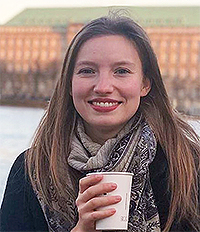Sandra Wellner

Email: sandra.wellner@sund.ku.dk
Affiliation:
University of Copenhagen
Department for Veterinary and Animal Sciences
Stigbøjlen 4
1870 Frederiksberg C
Education and Experience
In August 2017, I obtained my bachelor’s degree in general biology at the Free University Berlin, Germany. During the 3-year program, I have gained an insight into many different areas of biology including evolutionary biology and animal diversity, which I studied during my ERASMUS semester at the University of Sheffield, UK. My studies stirred my interest in molecular and especially microbiology and therefore I decided to join the group of Prof. Antelmann at FU Berlin. At first as a student research assistant, then as bachelor and finally as a master student, I investigated the oxidative stress response of Staphylococcus aureus caused by reactive oxygen species. In the Antelmann lab.
I was involved in several different projects, identifying the role of the Coenzyme A disulfid reductase Cdr and the quinone detoxifying enzymes MhqE and MhqD in S. aureus. Furthermore, I took part in a lab cooperation with Professor Ulrich Brandt (Radboud University, Nijmegen, Netherlands) where I analyzed the complexome of S. aureus after oxidative stress using blue native page and high throughput liquid chromatography. As part of my master’s degree, I got the opportunity to study molecular biology and immunology at the University of Stockholm, Sweden as an ERASMUS exchange student. In April 2020, I successfully completed my master’s degree with the specialization microbiology at the Free University Berlin.
After I had finished my master’s degree, I realized that I would like to continue my research more in the direction of identifying drug targets to treat antimicrobial resistance instead of fundamental research. I started to see bacteria not only as the model research organism but also as a useful tool for cloning or studying protein function in pro- or eukaryotes. Hence, I decided to use my previous knowledge about bacteria and transfer it to another field within molecular biology. During my internship at the Max Delbrück Center for Molecular Medicine in the lab of Dr. Izsvak, I designed a CRISPR Cas9 knock-in plasmid in E. coli to decipher the role of the transposable element ESRG in human pluripotency. In November 2020, I started an internship at the Mootha lab at Broad Institute of MIT and Harvard University at Massachusetts General Hospital (Boston, USA). In the Mootha lab, I investigated the beneficial effects of hypoxia on rare mitochondrial diseases such as Friedreich’s Ataxia using the model organism Caenorhabditis elegans. This project involved a screen to identify bacteria that can compensate the loss of frataxin, which is characteristic of Friedreich’s ataxia in C. elegans mutants.
In June 2021, I started my PhD in the group of John E. Olsen at the University of Copenhagen as part of the INNOTARGETS network.
ESR9 - The E. coli secondary resistome to aminoglycoside treatment
Project description
Multidrug resistant Enterobacteriaceae including E. coli have been classified as “critical” antibiotic resistant pathogens by the WHO. Hence, new strategies to develop antibiotics and preserve the current, valuable antimicrobials are urgently needed. Aminoglycosides have been used for decades and bacteria have evolved many resistance mechanisms to this class of antibiotics. One possibility to re-sensitise bacteria to aminoglycoside antibiotics is the identification of helper drugs. These helper drugs could target metabolic enzymes which are essential only during the expression of resistance genes termed collectively the ‘secondary resistome’.
The aim of my PhD project is to re-sensitize E. coli to aminoglycoside antibiotics by targeting the ‘secondary resistome’. In this project, E. coli strains resistant to streptomycin, gentamycin and neomycin will be constructed followed by construction and sequencing of transposon libraries. In the presence of aminoglycoside antibiotics, selected mutants will be characterized to test if these mutations can be used to re-sensitize E. coli to treatment with streptomycin, neomycin and gentamycin.
The secondments will take place at NAICONS (Italy) and at Oxford Brookes University (UK) to carry out metabolic modelling. In collaboration with NAICONS, a collection of bioactive molecules from bacteria will be tested to identify molecules that affect the identified part of the secondary resistome of the constructed strains. The selected molecules will be used to treat mice infected with aminoglycoside resistant E. coli as prove of therapeutic activity.
